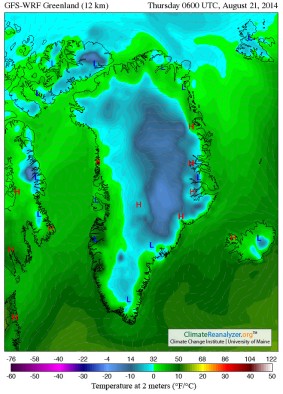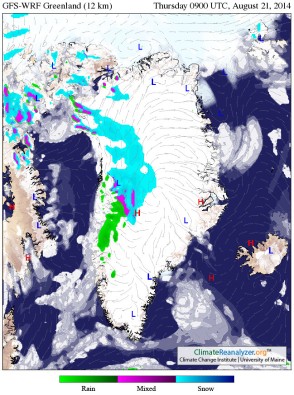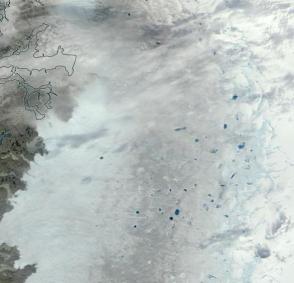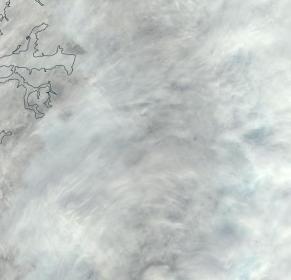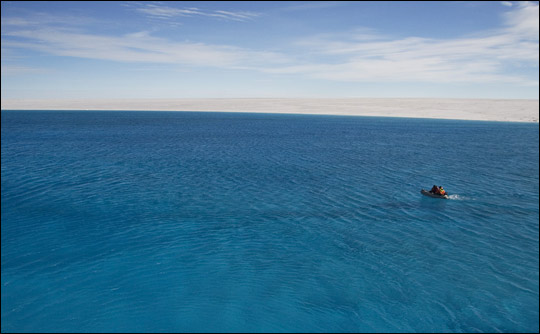These days — in the age of the fossil-fueled hothouse — it’s never good news when a high pressure system forms over Greenland during Summer.
Human dumping of carbon into the atmosphere has forced warming over the last remaining great Northern Hemisphere ice sheet at a rate of about 0.5 degrees Celsius each decade. A constant rain of soot from human industry and from increasingly prevalent and intense Arctic wildfires has painted the ice sheet dark, lowering its ability to reflect 24 hours of incoming radiation from the Summer sun. And the result is that each Summer, when the skies clear and high pressure systems form over the ailing Greenland ice, you end up getting these huge surface melt spikes.
(Smoke from record Alaskan and Canadian wildfire outbreaks traverses Greenland and enters the North Atlantic on July 2 of 2015. Arctic wildfires are intensified by human-caused warming both through the mechanism of added heat and through the reintroduction of long sequestered carbon fuels through permafrost melt which aids in the initiation, intensification and extension of Arctic wildfire burn periods. In essence soil carbon in the form of thawed permafrost and related methane adds to boreal forest, tundra and bog as burn risks. Soot from these fires can then precipitates onto land and sea ice, reducing its ability to reflect the 24 hour Summer Arctic sun. Image source: LANCE MODIS.)
Generally a big melt spike can be defined as anything greater than 35 percent of Greenland ice surface area. And we’ve had quite a few of these abnormal events in recent years. The worst of which happened in mid Summer of 2012.
During late June and early July of that year, an extreme high amplitude Jet Stream wave generated very warm surface temperatures over the Greenland Ice Sheet. A very warm fog settled over the ice, eating away at it. By July 8th, more than 90 percent of the surface was melting — an event that hasn’t happened in Greenland for more than 100 years. June, July and August of 2013 and 2014 saw similar, though somewhat less intense, Greenland melt spikes. During those years the ice sheet experienced multiple days in which melt covered between 35 and 45 percent of its surface. And though these instances were not as intense as the unprecedented 2012 melting, they did traverse well beyond the 1981 to 2010 average line (an average that itself includes a rapid warming trend) to, in cases, exceed the upper 2 standard deviation margin.
(Record Greenland surface melt during 2012 compared to still strong surface melt years of 2013 and 2014. Image source: NSIDC.)
After record 2012 melt, surface melt for Greenland has remained abnormally high — indicating an increased likelihood that more near 100 percent surface melt summer days may not be too far off in the future. The post 2012 environment for Greenland has thus been a period of continued and heightened surface melt. One that appears to be in the process of building up to another big pulse.
50 Percent Melt Threshold Exceeded During July of 2015
The summer of 2015 marks a continuation and intensification of this ominous surface melt trend. After getting off to about an average melt start during April and May, June saw surface warmth build over the Greenland Ice Sheet with melt extents jumping to between 30 and 40 percent of surface area by mid-to-late month. Further warming coincided with massive Alaskan and Canadian wildfires injecting soot plumes into regional airspace and the building of a substantial high pressure ridge over Greenland. These factors helped enable further atmospheric and ice warming — shoving surface melt above the 50 percent line by July 4th.
(Major Greenland melt spike indicated on July 1-5 in the NSIDC surface melt extent graph. Image source: NSIDC.)
This puts 2015 Greenland surface melt in a range well above 2013 and 2014, with the first week of July already exceeding 2012 melt for that period.
Over the next seven days, models predict a larger warming of the overall Arctic environment even as a high pressure system and associated ridge remains entrenched across Greenland. This predicted weather pattern will tend to lock in significantly warmer than 20th Century average temperatures. That said, forecast highs do not yet indicate a substantial risk for a repeat of 2012’s near 100 percent surface melt. However, projected high temperatures do show some potential that melt percentages are likely to continue to range between 40 and 60 percent surface melt over coming days with the highest risk for melt spikes occurring on July 6th, 7th and 8th.
It is worth noting that we are now in the midst of a substantial Greenland melt spike, one that we’ll continue to monitor over coming days for further developments.
Links:
Record Alaskan Wildfire Outbreak
Hat Tip to Wili
Hat Tip to Andy in San Diego
Hat Tip to Colorado Bob
Hat Tip to DT Lange





